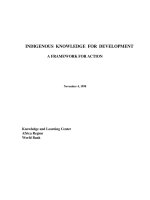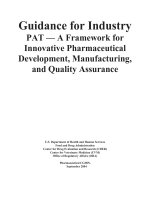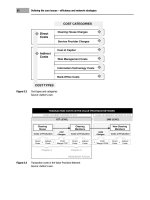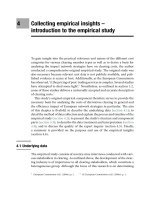New structural economics a framework for rethinking development and policy (world bank publications)
Bạn đang xem bản rút gọn của tài liệu. Xem và tải ngay bản đầy đủ của tài liệu tại đây (1.43 MB, 386 trang )
New
—Sir Partha Dasgupta
Frank Ramsey Professor Emeritus of Economics, University of Cambridge
“New Structural Economics is a truly important and ambitious book. Justin Lin,
with some help from other distinguished scholars, has succeeded in laying out the
complex structural microeconomic dynamics of economic growth, diversification
and development, and in capturing the crucial complementary roles of government
as investor, regulator, coordinator of activity and expectations, and guide. All of this
is set in a global economy that is itself in the midst of massive structural change.
This book will become an essential reference for scholars and for policy makers
not only in developing countries, but also, increasingly, in developed countries.”
—Michael Spence
2001 Nobel Prize in Economics
William R. Berkley Professor in Economics and Business, New York University
Leonard N. Stern School of Business
—Joseph Stiglitz
2001 Nobel Prize in Economics
University Professor, Columbia University
ISBN 978-0-8213-8955-3
90000
9 780821 389553
SKU 18955
Justin Yifu Lin
“The World Bank has long been committed to the goal of achieving a world
without poverty. In this brilliant volume, its Chief Economist, Justin Yifu Lin, lays
out an economic agenda for how to make this dream a reality. He argues that the
successes of China can be achieved elsewhere around the world, and explains
clearly and forcefully the structural transformations that will be required and
the role that government can and must play in that transformation. The book
will be a landmark in rethinking development. It provides an alternative to the
now discredited Washington Consensus policies that guided the Bretton Woods
Institutions for years. Justin Lin’s ideas have already stirred discussion and debate.
This book will ensure that they will continue to be central in the reexamination of
developmental policy.”
New Structural Economics
“This splendid collection of essays, by one of the world’s outstanding experts
on economic development, puts to work a newly emerging view, which he has
helped to shape, of why in recent decades some countries have prospered while
others have languished. Lin’s focus is on countries that were all economically
underdeveloped six decades ago, but his analysis offers strong hints about future
prospects of the rich world as well. His style is dispassionate and unadorned by
drama, which makes the essays all the more moving and illuminating.”
Structural
Economics
A Framework for Rethinking
Development and Policy
Justin Yifu Lin
New
Structural
Economics
New
Structural
Economics
A Framework
for Rethinking
Development
and Policy
Justin Yifu Lin
© 2012 International Bank for Reconstruction and Development / International Development
Association or
The World Bank
1818 H Street NW
Washington DC 20433
Telephone: 202-473-1000
Internet: www.worldbank.org
1 2 3 4 15 14 13 12
This volume is a product of the staff of The World Bank with external contributions. The
findings, interpretations, and conclusions expressed in this volume do not necessarily reflect
the views of The World Bank, its Board of Executive Directors, or the governments they
represent.
The World Bank does not guarantee the accuracy of the data included in this work. The
boundaries, colors, denominations, and other information shown on any map in this work
do not imply any judgment on the part of The World Bank concerning the legal status of any
territory or the endorsement or acceptance of such boundaries.
Rights and Permissions
The material in this work is subject to copyright. Because The World Bank encourages dissemination of its knowledge, this work may be reproduced, in whole or in part, for noncommercial purposes as long as full attribution to the work is given.
For permission to reproduce any part of this work for commercial purposes, please send a
request with complete information to the Copyright Clearance Center Inc., 222 Rosewood
Drive, Danvers, MA 01923, USA; telephone: 978-750-8400; fax: 978-750-4470; Internet:
www.copyright.com.
All other queries on rights and licenses, including subsidiary rights, should be addressed to the
Office of the Publisher, The World Bank, 1818 H Street NW, Washington, DC 20433, USA;
fax: 202-522-2422; e-mail:
ISBN (paper): 978-0-8213-8955-3
ISBN (electronic): 978-0-8213-8957-7
DOI: 10.1596/978-0-8213-8955-3
Library of Congress Cataloging-in-Publication Data
Lin, Justin Yifu, 1952New structural economics : a framework for rethinking development / by Justin Yifu Lin.
p. cm.
Includes bibliographical references and index.
ISBN 978-0-8213-8955-3 -- ISBN 978-0-8213-8957-7 (electronic)
1. Economic development. 2. Neoclassical school of economics. I. Title.
HD75.L56 2012
338.9--dc23
2011050744
Cover design and photo illustration: Critical Stages
Contents
Acknowledgments
Abbreviations
ix
xi
Introduction
1
I
II
New Structural Economics: A Framework
for Rethinking Development
11
Comments
by Anne Krueger, Dani Rodrik, Joseph E. Stiglitz
48
Rejoinder: Development Thinking 3.0: The Road Ahead
66
The Growth Report and New Structural Economics
81
with Célestin Monga
Debate: Should Industrial Policy in Developing Countries
Conform to Comparative Advantage or Defy It?
with Ha-Joon Chang
113
V
VI
|
Contents
III Growth Identification and Facilitation: The Role
of the State in the Dynamics of Structural Change
141
with Célestin Monga
Comments and Rejoinder
with Dirk Willem te Velde, Suresh D. Tendulkar,
Alice Amsden, K.Y. Amoako, Howard Pack,
Wonhyuk Lim, and Célestin Monga
IV Applying the Growth Identification and
Facilitation Framework: The Case of Nigeria
181
215
with Volker Treichel
V
Financial Structure and Economic Development
259
with Lixin Colin Xu
VI Development Strategy, Institutions, and Economic
Performance
285
VII Epilogue: The Path to a Golden Age of Industrialization
in the Developing World
349
Index
357
Box
IV.1: Applying the GIFF: Comparative Value Chain Analysis
228
Figures
IV.1:
IV.2:
IV.3:
VI.1:
Evolution of Total Factor Productivity
Total Factor Productivity Relative to the United States
Prioritization of Value Chains for Further Investigation
Relative Price of Production Factors and Technique Choice
220
221
235
293
Contents
VI.2:
VI.3:
VI.4:
VI.5:
VI.6:
VI.7:
VI.8:
VI.9:
|
VII
Product Choice in an Industry
Industry and Product Choices in an Economy
The TCI and Black-Market Premium
The TCI and the IEF
The TCI and Expropriation Risk
The TCI and Enterprise Autonomy
The TCI and Openness
Development Strategy and Income Distribution
294
295
323
324
325
326
327
334
Macroeconomic Aggregates, 2003–2009
Real Non-Oil GDP Growth, 2003–2009
Contribution to Non-Oil GDP
Labor Force Status
Types of Employment as a Percentage of the Sample
Population
Types of Wage Employment
GDP Per Capita PPP in 2009
Identifying Sectors for Growth: Key Exports of China,
India, Vietnam, and Indonesia
Nigeria’s Top Imports, 2010
Criteria for Screening Potential Subsectors
Average Wage, Including Benefits, by Industry
Growth-Inhibiting Cross-Cutting Constraints,
Interventions and Expected Outcomes
Level of Per Capita Income
Variable Definitions and Data Source
Development Strategy and Economic Growth—Model 1
Development Strategy and Economic Growth—Model 2
Development Strategy and Economic Volatility
The Effect of Development Strategy on Inequality
Development Strategy and the Performance of
Economic Reform/Transition
TCI Based on Value Added in the Manufacturing Sector
219
220
222
223
Tables
IV.1:
IV.2:
IV.3:
IV.4:
IV.5:
IV.6:
IV.7:
IV.8:
IV.9:
IV.10:
IV.11:
IV.A1:
VI.1:
VI.2:
VI.3:
VI.4:
VI.5:
VI.6:
VI.7:
VI.A1:
224
224
230
232
234
238
239
246
300
329
330
331
333
336
338
341
Acknowledgments
This volume presents the key findings of my research program on New
Structural Economics (NSE), which I conducted during my tenure as Chief
Economist and Senior Vice President of the World Bank from 2008 to
2011. This contribution to development economics and policy would not
have been possible without the overall guidance and support of Robert
Zoellick, President of the World Bank Group. I am grateful to Bob for his
encouragement and valuable advice over my tenure.
I am also very thankful to K. Y. Amoako, Alice Amsden, Ha-Joon
Chang, Anne Krueger, Wonhyuk Lim, Howard Pack, Dani Rodrik, Joseph
Stiglitz, Suresh Tendulkar, and Dirk Willem te Velde for providing insightful and detailed comments on the NSE framework. Their contributions
fueled a thought-provoking and enriching debate about the framework
and are presented in this book.
In addition, I would like to thank my many friends and colleagues
who provided thoughtful inputs and suggestions on various aspects of
the work presented here and throughout the research process. In particular, I am grateful to Shaida Badiee, Gary Becker, Otaviano Canuto,
Ha-Joon Chang, Robert Cull, Augusto de la Torre, Christian Delvoie, Asli
Demirgüç-Kunt, Shantayanan Devarajan, Hinh Dinh, Doerte Doemeland,
IX
X
|
Acknowledgments
Shahrokh Fardoust, Ariel Fiszbein, Robert Fogel, Alan Gelb, Indermit Gill,
Ann Harrison, James Heckman, Vivian Hon, Jiandong Ju, Auguste Tano
Kouame, Aart Kraay, John Litwack, Norman Loayza, Frank Lysy, Shiva
Makki, William Maloney, Célestin Monga, Mustapha Nabli, Vikram
Nehru, Ngozi Okonjo-Iweala, Howard Pack, Luiz Pereira da Silva,
Nadia Piffaretti, Claudia Paz Sepulveda, Brian Pinto, Zia Qureshi, Martin
Ravallion, David Rosenblatt, Sergio Schmukler, Luis Servén, Sunil Sinha,
Hans Timmer, Volker Treichel, Harald Uhlig, Lixin Colin Xu, Yong Wang,
and the many others whom I have had the pleasure and opportunity to
collaborate with during the production of the manuscript. I would like to
express special thanks to Doerte Doemeland, who worked closely with me
in the finalization and editing of the manuscript.
The research on NSE evolved from my previous work on economic
development and transition at the China Center for Economic Research
at Peking University. Several papers produced during that period are also
included in this volume. I would like to take this opportunity to thank my
former colleagues, Qiang Gong, Demin Huo, and Ho-Mou Wu, and former students, Binkai Chen, Shudong Hu, Feiyue Li, Yongjun Li, Zhiyun Li,
Mingxing Liu, Peilin Liu, Xifang Sun, Zhaoyang Xu, and Pengfei Zhang
for their support and collaboration in the research.
Last, the World Bank’s Office of the Publisher provided excellent editorial, design, and printing services under the direction of Carlos Rossel.
In this context, I would like to thank Santiago Pombo-Bejarano, Patricia
Katayama, Aziz Gökdemir, Andrés Meneses, and Martha Gottron.
Abbreviations
CAD
CAF
DC
GDP
GIFF
GMM
HRS
IEF
IMF
LDC
NIE
NSE
R&D
TCI
TFP
TVE
UNU-WIDER
comparative-advantage-defying
comparative-advantage-following
developed countries
gross domestic product
Growth Identification and Facilitation Framework
Generalized Method of Moments
Household Responsibility System
Index of Economic Freedom
International Monetary Fund
less developed countries
newly industrialized economies
New Structural Economics
research and development
Technology Choice Index
total factor productivity
township and village enterprises (China)
United Nations University – World Institute for
Development Economics Research
XI
Introduction
The quest for sustainable growth has been the most intriguing topic in the
world for economists and policy makers since Adam Smith’s An Inquiry
into the Nature and Causes of the Wealth of Nations was published in
1776. Measured by today’s living standards, all countries in the world
were poor at the beginning of the 18th century. Their economies were predominately based on agriculture. Growth of gross domestic product (GDP)
per capita had lingered at around 0.05 percent a year for millennia. Only
after the onset of the Industrial Revolution did per capita income growth
in the now advanced countries accelerate, jumping to around 1 percent a
year in the 19th century and doubling to about 2 percent in the 20th century. This was an unimaginable change. While it took about 1,400 years
for world income to double before the 18th century, the same process took
only about 70 years in the 19th century and only 35 years in the 20th century for the now advanced countries (Maddison 1995). Nevertheless, the
acceleration of growth was largely limited to the United Kingdom, where
the Industrial Revolution began, a few western European economies, and
Britain’s “offshoots”: Australia, Canada, New Zealand, and the United
States (Maddison 1982). The result was a great divergence in income
levels as the ratio of the top few to the majority bottom-income countries
increased from 8.7 in 1870 to 38 by 1960 (Pritchett 1997).
1
2
|
New Structural Economics
After World War II, most countries in the developing world gained
economic and political independence and started their postwar or postindependence reconstruction. By the end of the 20th century, a small set of
developing countries was able to achieve prolonged high growth, catching
up with or significantly narrowing their gap with the advanced industrial economies. Japan, in 1950 a developing country with a per capita
income one-fifth of the United States, reached 63 percent of U.S. income
by 1970 and became the world’s second-largest economy. Japan’s rise was
the result of an impressive annual growth performance of 9.6 percent during the 1950s and 1960s, driven by the transformation from an agrarian
to an industrial economy and continuous upgrading in key manufacturing
sectors. Using an outward-oriented, market-friendly development strategy, the Asian Tigers—Hong Kong SAR, China; the Republic of Korea;
Singapore; and Taiwan, China—grew in excess of 7 percent annually
between the early 1960s and the early 1990s, demonstrating that it is
possible to maintain impressive growth rates and to close the gap with
advanced economies. More recently, growth in several large economies,
such as China, Brazil, and India, has taken off, turning them into new
global growth poles (World Bank 2011). These high growth rates have
led to a significant reduction in poverty. Between 1981 and 2005, the
percentage of people living below US$1.25 a day was halved, falling from
52 percent to 26 percent. This drop in poverty was nowhere as apparent
as in my home country, China. In 1981 a staggering 84 percent of Chinese
lived in poverty. By 2005 this proportion had fallen to 16 percent—well
below the average for the developing world.
Although the occurrence of high, sustained growth further diversified
in the 21th century to some Sub-Saharan African and Latin American
countries, such growth still remains the exception rather than the rule.
Most developing countries suffered from prolonged uninterrupted spells of
anemic growth (Reddy and Minoui 2009). Between 1960 and 2009, only
about one third of low-income countries reached at least middle-income
status. Despite the rising weight of middle-income countries in supporting
global growth, many of them have been stuck in the “middle-income trap.”
Of the countries that were independent and had middle-income status in
1960, almost three-fourths remained middle-income or had regressed to
low-income by 2009. The ones that made it to high-income status are
Introduction
|
3
countries in Western Europe, Japan, the Asian Tigers, and two island economies in Latin America (Barbados and Trinidad and Tobago). If we can
learn from the failed development attempts by most developing countries
and especially the few successes, explore the nature and determinants of
economic growth, and provide policy makers with the tools to unleash
their country’s growth potential, poverty could become within a generation
or two a memory of the past.
Sustained economic growth cannot happen without structural changes
(Kuznets 1966). All countries that remain poor have failed to achieve
structural transformation, that is, they have been unable to diversify away
from agriculture and the production of traditional goods into manufacturing and other modern activities. In Sub-Saharan Africa, which constitutes
the core of the development challenge today, agriculture continues to play
a dominant role, accounting for 63 percent of the labor force. Its share of
manufacturing in 2005 was lower than in 1965 (Lin 2011). Recent empirical work confirms that the bulk of the difference in growth between Asia
and developing countries in Latin America and Africa can be explained
by the contribution of structural change to overall labor productivity
(McMillan and Rodrik 2011).
Development economics first became an independent subdiscipline of
modern economics after World War II. Various schools of first-generation
development economists in fact emphasized the importance of structural
change and saw structural differences as a result of market failures. Not
surprisingly, they proposed to use government interventions to facilitate
structural change through import substitution and gave priority to modern advanced industries. It was a period when new protective devices such
as quantitative restrictions on imports and exchange controls to manage
the balance of payments were first used on a large scale by most countries. Using Keynesianism as the main intellectual foundation for their
analyses, early development economists advocated a “dirigiste dogma”
(Lal 1983), positing as the central tenant of their theories that developing countries were irremediably different from industrial countries. Most
developing countries and multilateral development institutions followed
these policy recommendations. From Latin America to Europe, Asia, and
Africa, results were disappointing, and the gap with the industrialized
countries widened.
4
|
New Structural Economics
The failure of the government interventions inspired by the first-wave
development thinking generated a new wave, which highlighted government failures and adopted an astructural approach toward economic
development that emphasized the essential function of markets in allocating resources and providing incentives for economic development, ignored
the structural differences among countries at different levels of development in their policy recommendations, and expected the structural change
to happen spontaneously in a country’s development process.
Keynesian macroeconomics was also challenged by the emergence of
stagflation in the 1970s, the Latin American debt crisis, and the collapse
of the socialist planning system in the 1980s. The rational expectations
theory became the dominant intellectual framework for development and
helped refute the structuralist theoretical foundation for the state’s role in
using fiscal, monetary, and trade policy for economic development. The
new development thinking emphasized getting the price right, creating a
stable market environment, strengthening the institutions necessary for
markets to function well (property rights, good governance, business
environment, and the like), and building human capital (education and
health) to supply the increasingly skilled labor required by advances in
technology.
Multilateral institutions and development agencies were the main advocates for this wave of thinking and influenced economic policies in developing countries through their programs. They based much of their policy
advice and conditionality on stabilization and structural adjustment programs that reflected the new dominant paradigm and promoted economic
liberalization, privatization, and the implementation of rigorous stabilization programs. The results of these policies for growth and employment
generation were at best controversial.
Something strange and unexpected happened in the recent history of
economic development: it was observed that developing countries that
succeeded during the second half of the 20th century did not follow the
dominant development thinking or the policy prescriptions of the first and
second wave. That puzzling fact convinced researchers to revisit some of
the big assumptions underlying theories of economic development.
As pointed out, countries that have led the world growth since the Industrial Revolution and developing countries that have successfully converged
Introduction
|
5
with developed countries all experienced profound structural changes in the
composition of employment and the relative contribution of primary, secondary and tertiary sectors to aggregate growth. Drawing lessons from the
intellectual advances, controversies, and disappointments of development
economics, a third wave of development thinking, advanced by a small
group of economists such as Dani Rodrik, Ricardo Hausmann, Andres
Velasco, Philippe Aghion, Michael Spence, Ann Harrison, Célestin Monga,
myself, and a few others is well under way. It aims at bringing structural
change back to the core of development studies, and it emphasizes the
important roles for the market and the state in the process of promoting
economic development. These economists all agree that the market should
be the basic mechanism for resource allocation, but that government must
play an active role in coordinating investments for industrial upgrading
and diversification and in compensating for externalities generated by first
movers in the dynamic growth process.
The “New Structural Economics” presented in this book is an attempt
to set out this third wave of development thinking. Taking into account the
lessons learned from the growth successes and failures of the last decades,
it advances a neoclassical approach to study the determinants and dynamics of economic structure. It postulates that the economic structure of an
economy is endogenous to its factor endowment structure and that sustained economic development is driven by changes in factor endowments
and continuous technological innovation.
The factor endowments in a country are given at any specific time and
changeable over time. A country’s comparative advantages and thus its
optimal industrial structure are determined by its factor endowments.
Upgrading the industrial structure in a given country requires the upgrading of the factor endowment structure from one that is relatively abundant
in labor and natural resources to one that is relatively abundant in capital,
the introduction of new technologies, and the corresponding improvement
in infrastructure to facilitate economic operations. The new structural
economics argues that the best way to upgrade a country’s endowment
structure is to develop its industries at any specific time according to the
comparative advantages determined by its given endowment structure
at that time. The economy will be most competitive, the economic surplus will be the largest, and the capital accumulation and the upgrading
6
|
New Structural Economics
of factor endowment structure will be the fastest possible. For the private enterprises in a country to enter industries according to the country’s
comparative advantages, relative factor prices must fully reflect the relative abundance of those factors, and those prices can be determined only
through competition in a well-functioning market. Therefore, the market
should be the basic institution of the economy.
For the introduction of new technologies, developing countries can turn
their backwardness into an advantage by borrowing or adapting technologies that have already matured in richer economies. In contrast, advanced
economies must produce at the global technology frontier and have to
invest continuously in new R&D to achieve technological innovation.
Hence developing countries have the potential to achieve a rate of technological innovation several times higher than that of advanced countries.
Upgrading the industrial structure as well as the corresponding improvement in infrastructure, however, entails coordination of investments and
compensation for externalities generated by first movers that cannot be
internalized by private enterprises. Without this coordination and compensation, the process of economic development will slow. The government should therefore play an active role in facilitating structural change
through mitigating the coordination and externality problem.
Chapter I reviews the evolution of development thinking and presents
the main arguments and extensions of New Structural Economics. This
chapter also includes insightful comments on the framework from my colleagues Anne Krueger, Dani Rodrik, and Joseph Stiglitz and my rejoinder
to their comments.
Chapter II shows how the New Structural Economics complements previous thinking on development and growth. It compares the predictions
derived from the New Structural Economics with the stylized facts of successful countries identified by the Growth Report issued in 2008 by the
Commission on Growth and Development and discusses the policy lessons
that can be drawn from the New Structural Economics. The principle of
comparative advantage and the role of the state in facilitating structural
transformation, which are key aspects of the framework, are further discussed in a subsequent debate between Ha-Joon Chang and myself.
The Growth Identification and Facilitation Framework (GIFF), which
lays out a step-by-step approach for policy makers to facilitate structural
Introduction
|
7
change based on the framework of the New Structural Economics, is
presented in chapter III. It guides policy makers on how to identify new
industries consistent with a country’s latent comparative advantage. It
also presents information, coordination, and externality issues intrinsic
to industrial upgrading and discusses government policies that can help
overcome these constraints. Explaining why industrial policy has often
failed in the past, the chapter also warns against government policies that
are aimed at protecting selected firms and industries that defy a country’s comparative advantage. Dirk Willem te Velde, Suresh Tendulkar,
Alice Amsen, K. Y. Amoako, Howard Pack, and Wonhyuk Lim provide
thought-provoking comments on the approach. The chapter concludes
with a rejoinder.
Chapter IV illustrates how to apply the GIFF in developing countries.
Using the example of Nigeria, the chapter identifies appropriate comparator countries and selects a wide range of industries in which Nigeria may
have latent comparative advantage as the comparator countries may be
losing theirs. The chapter argues that these industries, which include food
processing, light manufacturing, suitcases, shoes, car parts, and petrochemicals, may lend themselves to targeted interventions of the government. The paper also discusses binding constraints to growth in each of
these industries’ value chains as well as mechanisms through which governance-related issues in the implementation of industrial policy could be
addressed.
Chapter V focuses on the question of financial structure and development. Financial structure varies significantly across countries and,
within a country, at different levels of development. The chapter argues
that the optimal financial structure in an economy is endogenous to
real demand for financial services based on industrial structure, which
in turn hinges on a country’s comparative advantages. Historically, the
financial literature has argued that financial depth rather than financial structure matters for economic development. This chapter provides an overview of theoretical and empirical advances that support
the notion that financial structure is important for economic development and endogenous to its industrial structure. It also discusses the
circumstances under which the actual financial structure deviates from
its optimal structure.
8
|
New Structural Economics
The New Structural Economics argues that countries that pursue a
comparative-advantage-following development strategy perform better
than other countries. In chapter VI, the book presents empirical evidence to
support this notion. It shows that countries that follow their comparative
advantage have higher growth, lower economic volatility, and less inequality. It argues that the failure of most developing countries to converge with
advanced economies can be explained largely by their governments’ inappropriate development strategies. In the past, governments placed priority on the development of certain capital-intensive industries rather than
focusing their efforts on upgrading a country’s endowment structure and
creating an enabling environment for the development of sectors aligned
with a country’s comparative advantage.
Chapter VII points out that as wages rise rapidly in dynamically growing emerging market economies, such as China, India, Brazil, Indonesia
and others, in the multipolar growth world of the 21st century, the laborintensive industries in those emerging market economies will be losing
comparative advantages and provide golden opportunities for other lowincome countries to enter. China alone currently has 85 million manufacturing jobs in labor-intensive industries. If low-income countries in Africa
and other parts of the world are able to seize these jobs, they will be able
to grow dynamically, reduce poverty, and improve living standards quickly.
Lower-income countries should therefore turn their late-comer status to
their advantage by identifying mature industries in carefully selected lead
countries and facilitating the entry of their own private enterprises or foreign direct investments from the comparator countries into those industries. This chapter also summarizes key policy messages and provides concluding thoughts.
As stated in the annual UNU-WIDER Lecture that I delivered in Maputo
on May 4, 2011, I believe that every developing country, including those in
Sub-Saharan Africa, can grow at 8 percent or more continuously for several
decades, significantly reducing poverty and becoming middle- or even highincome countries in the span of one or two generations, if its government
has the right policy framework to facilitate the private sector’s development
along the line of its comparative advantages and tap into the late-comer
advantages (Lin 2011). I hope that the publication of this book will make a
contribution toward the realization of that goal in the developing world.
Introduction
|
9
References
Kuznets, S. 1966. Modern Economic Growth. New Haven, CT: Yale University
Press.
Lal, Deepak. 1983. “The Poverty of ‘Development Economics.’” Institute of
Economic Affairs, London.
Lin, Justin Yifu. 2011. “From Flying Geese to Leading Dragons: New Opportunities and Strategies for Structural Transformation in Developing Countries.”
WIDER Annual Lecture 15, Helsinki: UNU-WIDER. (A shorter version of this
paper is forthcoming in Global Policy.)
Maddison, Angus. 1982. Phases of Capitalist Development. Oxford, UK: Oxford
University Press.
———. 1995. Monitoring the World Economy, 1820–1992. Paris: OECD.
McMillan, Margaret, and Dani Rodrik. 2011. “Globalization, Structural
Change and Productivity Growth,” Kennedy School of Government, Harvard
University, Cambridge, MA., />Research%20papers/Globalization,%20Structural%20Change,%20and%20
Productivity%20Growth.pdf.
Pritchett, Lant. 1997. “Divergence, Big Time.” Journal of Economic Perspectives
11 (3): 3–17.
Reddy, Sanjay, and Camelia Minoiu. 2009. “Real Income Stagnation of Countries
1960–2001.” Journal of Development Studies 45 (1): 1–23.
Spence, M. 2011. The Next Convergence: The Future of Economic Growth in a
Multispeed World. New York: Farrar, Straus and Giroux.
World Bank. 2011. Global Development Horizons—Multipolarity: The New
Global Economy. Washington, DC: World Bank.
I
New Structural
Economics:
A Framework for
Rethinking
Development









